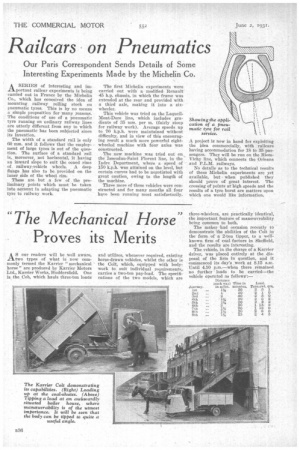Railcars on Pneumatics
Page 54

If you've noticed an error in this article please click here to report it so we can fix it.
Our Paris Correspondent Sends Details of Some Interesting Experiments Made by the Michelin Co.
ASERIES of interesting and important railcar experiments is being carried out in Prance by the Michelin Co., which has conceived the idea of mounting railway rolling stock on pneumatic tyres. This is by no means a .simple proposition for many reasons. The conditions of use of a pneumatic tyre running on ordinary railway lines are utterly different from any to which the pneumatic has been subjected since its invention.
The width of a standard rail is only 60 mm. and it follows that the employ-. ment of large tyres is out of the question. The surface of a standard rail is, moreover, not horizontal, it having an inward slope to suit the coned rims of. railway-vehicle wheels. A deep flange has also to be provided on the inner side of the wheel rim.
These are but a few of the preliminary points which must be taken into account in adapting the pneumatic tyre to railway work. The first Michelin experiments were carried out with a modified Renault 45 h.p. chassis, in which the frame was extended at the rear and provided with a third axle, making it into a sixwheeler.
This vehicle was tried on the LaqueilMont-Dore line, which includes gradients of 25 mm. per m. (fairly steep for railway work). Average speeds up to 70 k.p.h. were maintained without difficulty, and in view of this encouraging result a much more powerful eightwheeled machine with four axles was constructed.
The new machine was tried out on the Issoudun-Saint Plorent line, in the Indre Department, where a speed of 150 k.p.h. was attained on the level, but certain curves had to be negotiated with great caution, owing to the length of the machine.
Three more of these vehicles were constructed and for many months all four have been running most satisfactorily. A project iS now in hand for exploiting the idea commercially, with railcars having accommodation for 18 to 35 passengers. They will be run on the RiomVichy line, which connects the Orleans and P.L.M. railways.
No details as to the technical results of these Michelin experiments are yet available, but when published they should prove of great interest. The crossing of points at high speeds and the results of a tyre burst are matters upon which one would like information.




































































































